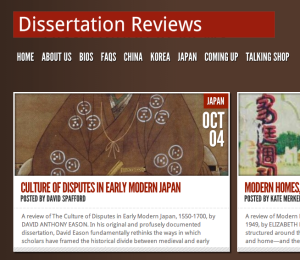[Note: To read this review on the new Dissertation Reviews site, click here]
Thoroughly reexamining the religious policies and administrations of the Liao, Northern Song, and Jin states, Contending States and Religious Orders in North China and in East Asian Context, 906-1260 successfully provides us with a whole new understanding of the history of the “conquest dynasties” and North China from the 10th to 13th centuries. The religious policies of the “conquest dynasties” have long been considered as manifestations of the excessive religious devotion of their individual ruling houses. Jesse Sloane looks at the religious policies as historically related and successive phenomena beyond the question of dynasties changes. He then goes on to demonstrate that those policies were all deeply influenced by religious trends in northern Chinese society during the same period.
This dissertation is divided into seven chapters. After the introductory chapter one, chapter two examines the adoption and development of religious policies during the early years of the Liao and Song states. Through a careful, elaborate analysis of the context of the relevant materials, the author reveals that Buddhism and Confucianism did not necessarily have a significant influence over the Khitan Court, even as source materials indicate that early qaγans occasionally protected and patronized them. At the same time, the Song state postured itself as a successor to the Tang state in translating and printing Buddhist scriptures and, soon after it was founded, resumed an endeavor that would result in creating a Buddhist canon capable of mass replication and distribution.
Chapter three discusses the changing self-recognition of the Liao and Song states by examining their religious policies through the mid-11th century. After establishing its military hegemony in East Asia, the Liao monarchs turned their attention to the imperial patronage of enduring projects of the Buddhist clergy, such as the printing and publishing of Buddhist scripture. On the other hand, the emergence of Daoism and Confucianism complicated the religious policies of the Song dynasty. Based on the stone inscriptions, chapter four first looks at the rise of lay activism in the southern fringe of the Liao realm, and then discusses how the Liao monarchs, adopting the precedents of the Song emperors, vigorously expanded their patronage over the publication of canons and the establishment of temples and pagodas. In the contemporary Song dynasty, while relinquishing its superior position vis-a-vis the question of Buddhist textual authority, and abandoning the publishing of Buddhist scripture, the state strengthened and further systematized administration over religious orders, eventually resulting in Huizong’s 徽宗 ambitious endeavor to establish a Daoist monarchy. Within this process, the author finds a dominant trend toward separating religious elements from foreign policies and using them domestically, while the flow of Buddhist texts and scriptures became more and more active between Liao, Song, Koryŏ, and Japan.
Chapter five denies the received perception of Jin imperial religious policies, namely that their “tribal” and “nomadic” elements inherited from the Liao predecessors were later, though attempts to revive “Jurchen traditional culture,” assimilated to “Chinese” and “Confucian” norms. Instead, the author shows that steady continuity is found in the religious policies of the Jin. It is demonstrated empirically that, from the earliest to the closing years of the Jin period, although each emperor had different preferences in regards to religious practice, the state consistently supported, recognized, and acknowledged the cult of Confucius, Buddhist organizations, and the new and rising Daoist sects. The author argues that this conspicuously proves that the Jin dynasty was quite thoughtful in answering the religious expectations of its subjects. Following this conclusion, chapter six analyzes the Jin state’s regulation and imperial patronage of Buddhist and Daoist orders. The author demonstrates that, when facing religious activism in local society, the goal of the Jin’s religious policies and imperial patronage was in many cases to balance and mediate between religious orders. To achieve this goal, the Jin state adopted the religious administration system of the preceding Liao and Song states.
Chapter seven provides us a summary of the dissertation’s many insights. It argues that, when considering questions of social and religious continuity and transition, the compartmentalization of the Liao and Jin into separate “conquest dynasties,” as well as the maintenance of disciplinary division between the Song and its others, only hinders our understanding of the history of North China during the 10th to 13th centuries. Instead, by taking “religion” as an administrative concept, it should be understood that there was a systematic continuity and mutual influence in the religious policies of the monarchs of the Liao, Song, and Jin states. At the same time, the religious patronage and self-recognition of each of the monarchies in most cases is not understood as the manifestation of “autocracy” of a particular “foreign” monarch or ruling house who was predisposed to revere the Buddhist clergy, but as one part of the ongoing efforts by monarchs to better control religious orders in their realms. In addition, Sloane also calls attention to the significance of the religious policies to inter-state relations. The flow of Buddhist canons, scriptures, and monks illustrates the types of inter-state relations the dynasties normally eschewed during the 11th and 12th centuries.
Over the past three decades, dozens of important works on the social history of the middle to late imperial Chinese periods have been published – and in most cases they focus exclusively on the South. Recently, a collaborative effort resulted in the publication of Paul Jacov Smith and Richard von Glahn, eds., The Song-Yuan-Ming Transition in Chinese History, Cambridge (Massachusetts): Harvard University Press, 2003, which added great depth to our understanding of the social continuity and discontinuity in the South from the middle to the late imperial period. In this path breaking dissertation, Sloane’s greatest contribution is his juxtaposition of “northern Chinese society” and its well-studied southern counterpart. The most striking success of this dissertation lies in the way it breaks down the dynastic compartmentalization by demonstrating the continuity of dynastic policies and the religious practices in society. By doing so it illustrates a decompartmentalized perception of northern Chinese history, which will form a solid academic foundation for the further development of the historiography of the middle and late imperial periods.
Tomoyasu IIYAMA (飯山知保)
Assistant Professor
Waseda University
t-yama@aoni.waseda.jp
Primary Sources
Liao Shi (1974)
Jin Shi (1975)
Zhonghua da zang jing (1984)
Liao-Jin-Yuan shike wenxian quanbian (2003)
Dissertation Information
Princeton University. 2010. 430pp. Advisor: Benjamin A. Elman.




